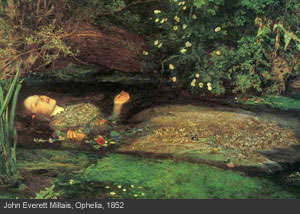
Abstract: In my SMP, I interpret the naturalism in Pre-Raphaelite painting in terms of the developing technology of photography. I analyze the similarities among the Romantic approach to naturalism, the Romanticism of the Pre-Raphaelite’s medieval subjects, and the conceptualization of early photography. Through these comparisons I demonstrate that in the Pre-Raphaelite work the past, present and future can coexist in a single moment.
The Pre-Raphaelite Brotherhood worked in an era alive with paradox, a culture caught between enthusiasm for technological innovations and a collective longing for a mythical, idyllic past. They focus on reproducing the details natural world as carefully as possible, focusing on details so as to render the scenery and the subject as vivid and as wild as in the real world, an affect known as naturalism. Two major intellectual forces shaped this style: the writing of famed Victorian critic John Ruskin and the earlier work of the Romantic poets. It was the work of the latter that largely informed the Pre-Raphaelite source of subject matter, as the Romantics emphasized the potency of nature through an emotional state they referred to as the “sublime”. In order to demonstrate the sublime, the Pre-Raphaelites set their works in worlds of beautified medieval drama, scenes far removed, both temporally and conceptually, from industrialization.
Rejection of the pervasive influence of middle-class taste characterized the mood behind the formation of the Brotherhood. The Brotherhood perceived a distinct lack of sophisticated ideas throughout much of the work the Academy accepted. They sought to pr their work with symbolism, in order to connect with the more intellectually vigorous artistic work that the Pre-Raphaelites admired in Italian art just before the Renaissance.